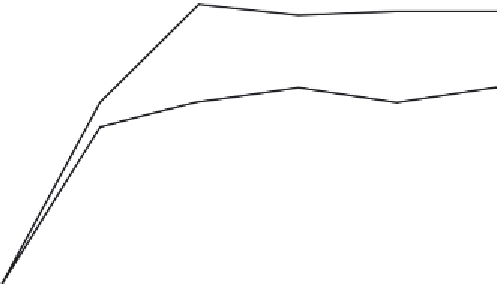Biology Reference
In-Depth Information
(CS)-unconditioned stimulus (US)-reward constitute the acquisition
phase of learning. Bees vary in how many trials it takes to respond
without the US (Figures 2.10 and 5.10). High-strain bees require fewer
trials than low-strain bees. Pollen-foraging wild-type bees, like high-
strain bees, require fewer trials than do nectar foragers. Following the
acquisition trials comes the extinction phase, where bees are presented
with the CS without reward. h e bees learn to ignore the unrewarded
stimulus. Bees are also tested for their ability to discriminate between
two stimuli. In the case of tactile learning, they discriminate between a
copper plate with vertical etchings and one with horizontal etchings.
Similar learning assays have been conducted using odors. Preforag-
ing high-strain bees and pollen-foraging wild-type bees have better
100
80
60
40
20
Pollen Foragers
Nectar Foragers
0
1
2
3
4
5
Acquisition Trials
Figure 5.10.
Acquisition curves of pollen and nectar foragers in tactile antennal
learning. h e
x
-axis shows the acquisition trials. h e
y
-axis shows the percentage
of bees displaying the conditioned proboscis extension response (PER). Both
groups have reached the plateau of their acquisition function at er three
acquisition trials. However, the level of acquisition is higher in pollen foragers
than in nectar foragers.





























